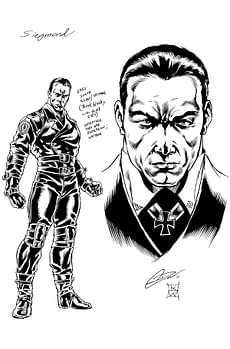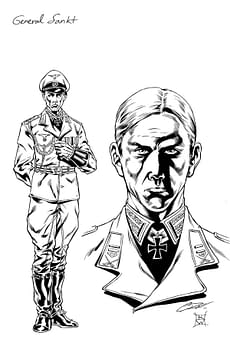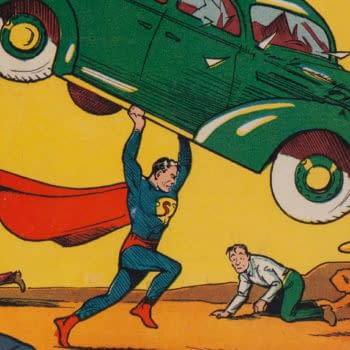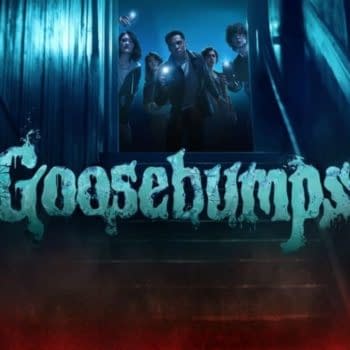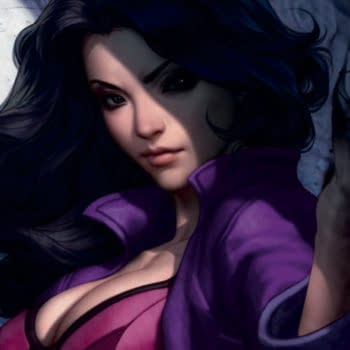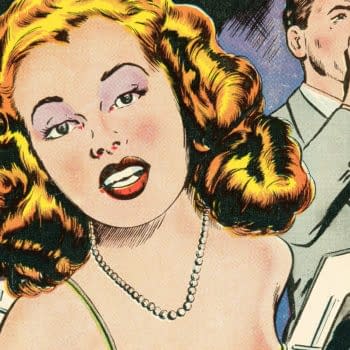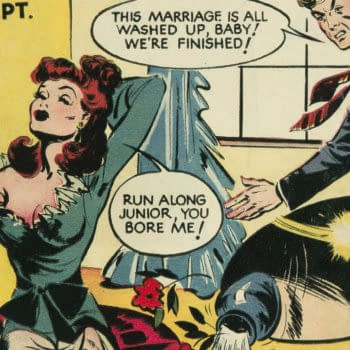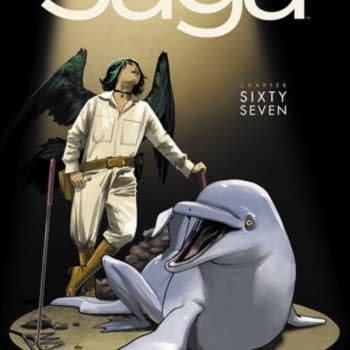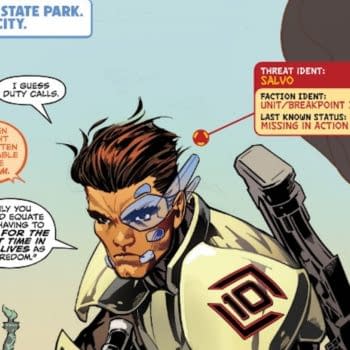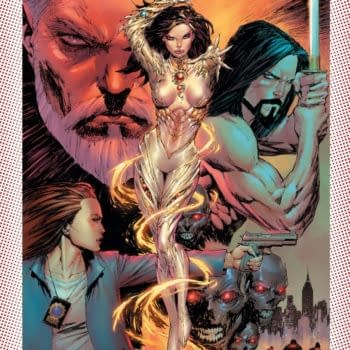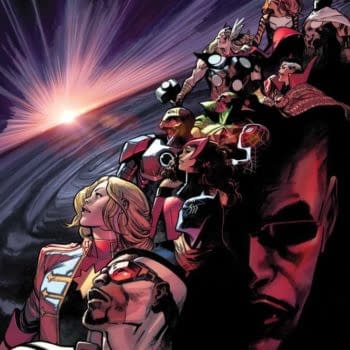Posted in: Comics, Recent Updates | Tagged: avatar press, canaan white, Comics, kieron gillen, uber, wwii
Kieron Gillen Talks About His New Series Uber – War, Weaponized People, And Writing Angry

Germany is in ruins. The war in the west can only be days away from ending. Threats of "wunderwaffen" to be unleashed by the dying Reich have become laughable. There are no miracle weapons here. It's over. It has to be over.
It's not. There's been stories which have mixed enhanced humans and World War 2 before. There's never been one like this.
What makes this one different? Let's get inside Gillen's head and find out:
What was your inspiration for the new Avatar monthly series, Uber?
Kieron Gillen: It's an odd one. 5 years ago, William came to me expressing the desire to do a WW2 comic based around an armed race around enhanced humans, in the Avatar style. I had a little think, and came back with this 30,000 word bible for the whole series. The odd thing is that I wasn't immediately excited. I was thinking "Hasn't WW2 superheroes been done enough?" and I sat down and realised, no, they hadn't and I a mass of I needed to say would be perfectly served by doing a story powered by that conceit.
Uber hasn't a single wink at the camera. It lacks any meta. In fact, I suspect its lack of meta will be taken as a statement of meta – in that we're far too inwards looking as a creator culture, and think too much about what our books say about the genre rather than what the genre can say about human existence.
But inspiration? I think it just comes from how much WW2 still hangs over us even now, and watching the crowds thin in veteran's reunions. It comes from a somber, horrified and angry place.

Thankyou. That said, I'm sure serious WW2 buffs will be able to pick over my errors. I'll say I've done more than most. The time when some German friends came to visit to find me crouched in the front room, in front of a map of Berlin circa 1945, with piles of Nazi biography beside me and the World at War playing on the television still horrifies me even now, y'know?
Basically, I'm not Garth Ennis. I had a casual historical knowledge of the period. To do this, I had to dig into the books a little harder. It's a "Where was Heinz Guderian on May 29th 1945" kinda book, at times.
So yes, this was about my approach. If I was going to do a serious story about WW2 I had to at least try.
Fans love your work on Phonogram and Invincible Iron Man, what would you tell those supporters who are interested in finding out what Uber is all about?
I actually think Phonogram readers may have trouble realising this is by me. Between THREE and UBER, 2013 will be showing the side of my creative urges that has been pretty well hidden by now.
Of all the books I've done, I see the most cross-over between UBER and Uncanny X-men in its themes. It's about those sort of moral questions.
What was your inspiration for the Ubers?
It's about the approach as much as anything. That's the key idea. This is a book about weaponized people. I wanted the ubers to feel like that. You know those bits in a Garth Ennis war comic when he drops a fact about the problem's in a plane's design or whatever? The Ubers should feel like that. That as we move through the versions, we see the quirks pop up. These are lived in.
And… you know tanks? They're hard fuckers. But the second a helicopter gunship pops over the horizon, they're toast. In a 1:1 fight, the tank is always, always going to lose. One just trumps the other.
That's how Uber is constructed.
Heroic action fiction works by them overcoming these odds. It doesn't matter if you can only lift 10 tons and the other guy can lift 100 – if you're a true and brave hero, you're going to overcome. It's about the plot, and what it says about humans. Which is great, of course. But Uber doesn't work like that. It works like a simulation. Sometimes people are just screwed.
That's the inspiration for the Ubers.
This is a war story, not a piece of heroic action fiction. There are heroic moments, but they're of a very different character to that.
For the "Battleship" Ubers – the main characters, who are much more powerful than the rank and file – I was mainly inspired by the position of Battleships at the start of WW2, and how for the majority of the war even the names of the real monsters made people scared. They just hoped one of them wouldn't turn up.
(And it's not as if they often did, as they were too expensive to risk losing.)
In terms of the personalities of our lead Ubers, I looked at what I wanted to say. They're all clearly defined individuals, and none are exactly what they first appear.

That comes from the previous question, a little. These are hardware, and there's a reason why Tanks didn't win wars by themselves.
And some of it is practicality. The book starts very shortly before where Berlin surrendered. The Reich is destroyed. When designing the Ubers, I had to make sure they were powerful enough to ensure that the war didn't come to an end, but not so powerful that they immediately won the war and we go into "What If Nazi Germany Won WW2" territory. I wanted to do a story about WW2 extending, so the characters had to allow it.
For example, when we start, we don't have any Ubers who can fly, because an Uber that can just pop over to London or New York and stomp it flat immediately changes everything.
We don't start with that.
Will the Allies have their own super humans or does Germany have the only source for these game changing weapons?
The origins of the Ubermensch program is a deliberate mystery at the opening. We see a lot about how it actually works, but there's clearly things I'm not telling you. So, as we begin, the Allies appear to have no idea that the Ubermensch program exist. They're on the back foot. Starting off their own program as quickly as possible is the first thing they have to worry about. That's part of the tone of the book – the Allies are on the back foot, and they're trying to catch up.
Avatar is well known for giving big name creators the freedom to create extreme projects that other publishers would shy away from. What drew you to Avatar for this project?
No-one else but Avatar would do this project.
What are your long term goals with Uber? Does it go beyond World War II? Will there be a point in the series where we shift into the present day and see how the introduction of these monsters impacted the last seventy years?
Good questions all.
The original Bible goes to the end of this extended WW2, and presents a new world. It could certainly continue from there. It could certainly skip forward. One of the book's tropes is that the captions have a tendency to write as if part of a historical text. That implies some kind of future.
(I always loved the afterword in 1984, in passing.)
The other possibility is fun too. The book is big and wide. We touch on all the major theatres… but there's also room to explore inside the setting. If Uber was successful enough, I'd love to see spin-off minis exploring some of the side stories. There's plenty of room for that.
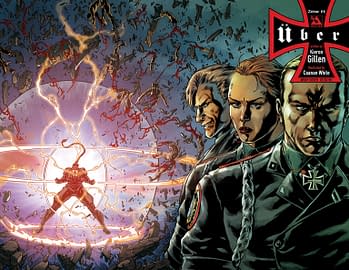
No. It will never be – and could never be – anything like any traditional superhero universe. We start with two forms of ubermensch – the low level "Panzermensch" and the three Battleships. The power-set is actually identical between them, only differing in terms of scale. This changes as we progress – and the development of new sorts as we move on – but it's still not a book about making up guy's unique powers. Even at the start, Germany has several hundred close-to-identical superheroes, plus these three battleships.
This is about the weaponisation of people. Weapons aren't really much about the individual's personality. These characters are more likely to have a serial number than a costume, and the conflict between that and their humanity is absolutely what I'm interested in.
It's also a single-origin universe. There is a single element I've added to the universe, and everything else follows from that. It's always going to feel towards the science-fiction end of the genre because of that.
How do you approach writing Uber? Is there a ritual you take to get in the mind frame to write stories about the motivations and actions the Nazi enforcers were undertaking?
It's hard work, both in terms of research and the emotions you have to go through. I write it angrily. That coming back to Uber means that I normally start reading around the subject always leaves me fuming. Any time you read about WW2, and really try to comprehend what it means, you end up this seething mess. Any given paragraph in any historical book contains a thousand novels. You can't hope to do justice to it, and all I can do is try.
In terms of listening? It's normally classical music. Perhaps unsurprisingly, the Ring Cycle is under heavy rotation.
The strange thing is the time difference. I wrote the first (double sized) script five years ago. It was actually before I wrote anything in the main Marvel Universe, y'know? The second issue was almost a couple of years after that, and the rest (I'm up to 11 now) being written along time from. I've been doing some fairly heavy editing on the early stories in lettering with an eye on what I've learned since then.
What can we expect from the ongoing Uber series in months to come?
Variety. Each arc is based roughly on a historical period and theatre. So all the ones leading up to issue 5 are the first impact of the Ubers to the world, climaxing in the first full battle between allied and Nazi ubermensch. And then we let our focus change, spending a couple of issues in each theatre. We touch on high level strategy, production and economics and then focus tight on the people whose lives are being effected.
It's not a book about superhumanity. It's about humanity and inhumanity.
Oh yeah – I mentioned the notes on genre earlier. I'll stress that. It's a war story. No-one is safe.
Kieron Gillen's Uber Character Notes, With Design Art by Canann White
Distortion Halo: This is one of the series' signature effects, and I gave a bunch of notes and we came back with this. I was thinking about my first aid class, and how I was taught "gunshot wounds" in a category entirely separate from any other kind of wound. This is its own thing. I wanted the Halo to created effects that were its own thing. Thinking how this power would interact with flesh was a big part of that.
Siegmund/Siegfried/Sieglinde:
Our three Battleship Ubers. No helmet, which works for both practical reasons of being a narrative comic (i.e. we can ID them) and a statement of how they're different. When designing their clothes, the main note was that they are much harder than whatever they're wearing can be. The clothes aren't designed to protect – they're designed to stay on in the extreme environments. All the impractical banding would constrain humans, but they're strong enough it really doesn't matter.
You'll note on her badge here we have Sieglinde's original code-name, which was Brunhilde. I wanted to keep the "all of these have a name that starts with the same letter" as a nod towards certain naval traditions which I suspect Sankt liked.
The names are all from the ring cycle. No, they're not their real names.
Militant Uber Designs:
These are steps towards our Panzermensch. You'll note the lighter leather armour here, and various designs of the helmet. We ended up with a design that didn't have the goggles, yet moved in more catastrophically around the eyes. There's in story reasons for that, as we'll see.
Professor Metzger/Freya Bergen:
Nazi Scientists. Our entry point into the the R&D and production side of Uber.
 General Sankt:
General Sankt:
Sankt is the architect of the Uber program, and one of the key figures of the book. He basically sees himself as a visionary of Uber warfare. When tanks were introduced in WW1, they basically did fuck all. No-one really knew how to apply them. Hell, Stalin's military purges in the 30s left the USSR with generals who didn't believe tanks had any use in warfare at the start of WW2. It was men like Guderian who worked out the theories of tank warfare, which were instrumental in early German success in WW2.
(Guderian is actually another key character in Uber.)
Anyway – Sankt thinks his theories have leapfrogged the idiot stage and go straight into the deploying-these-for-maximum-
He's a bit of a fucker.
Maria: Soviet Sniper. Nicknamed "katyusha" after the rocket launchers. One of my favourite non-Uber designs. Nailed her entirely.
HMH Colossus: Patrick is the first allied Uber. Named after the proto-computer at Bletchley Park. The codebreakers' HQ is absolutely central to Uber. Amazing buildings. I highly recommend anyone go and visit.
(And, yes, Turing is among the historical figures I have a shot at writing.)
The early allied uniforms are far less ornate than the German ones, simply because they're being produced on an ad hoc basis.






